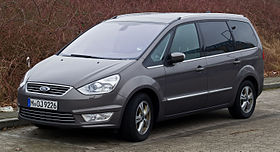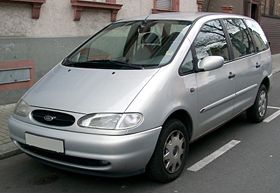
Ford Galaxy 1995- Present

| Ford Galaxy | |
|---|---|
 |
|
| Overview | |
| Manufacturer | Ford Europe |
| Production | 1995-present |
| Body and chassis | |
| Class | Large MPV (M) |
| Body style | 5-door MPV |
| Layout | Front-engine, front-wheel-drive |
The Ford Galaxy is a large multi-purpose vehicle (MPV) produced by Ford Europe.
It was first introduced in June 1995, and since then has spanned over three generations. From 2006, the Galaxy has been developed alongside the closely related Ford S-Max using the Ford Mondeo's platform.
First generation (1995−2006)
| First generation | |
|---|---|
 |
|
| Overview | |
| Production | 1995–2006 |
| Assembly | Palmela, Portugal (AutoEuropa) |
| Designer | Greg M Greeson (1990) |
| Body and chassis | |
| Platform | Volkswagen Group B-VX62 |
| Related | Volkswagen Sharan SEAT Alhambra |
| Powertrain | |
| Engine | petrol engines: 2.0i DOHC 2.3i DOHC 2.8i VR6 diesel engine: 1.9 TDI 90 bhp (67 kW) or 110 bhp (82 kW) |



The first Galaxy was designed as a joint venture product between Ford and the Volkswagen Group. Produced at the joint-venture AutoEuropa plant in Palmela, Portugal, the vehicle was badge-engineered to create three vehicles: the Ford Galaxy; by Volkswagen Passenger Cars as the Volkswagen Sharan; and by SEAT as the Alhambra.
The Galaxy used predominantly Volkswagen Group mechanicals, most notably the 2.8 litre VR6 petrol engine from the top versions of the Volkswagen Golf, as well as Volkswagen Group's 1.9 litre Turbocharged Direct Injection (TDI) turbodiesel unit. Initially only the 2.0 litre inline-four petrol version used a Ford powerplant – this derived from the Ford I4 DOHC engine. In later years, this unit was supplemented by a 2.3 litre 16 valve version first seen in the facelifted Ford Scorpio. This engine was transversely mounted (as with the MKV Escort RS2000) as opposed to longitudinal mounting like in the Ford Scorpio.
All of the VW Group sourced engines were supplied with "Ford" badges on the rocker covers, despite being VW Group designs. All automatic transmissions were VW Group AG4 boxes, but manual gearboxes on all engines were VXT75 five speeds (modified versions of the trusted Ford MTX-75 five speed set-up to suit the transverse engine layout).
The original interior used a mix of both Ford and VW Group components, using a Golf-derived instrument pack, and most of the switchgear, while the curved fascia moulding was of Ford design, heavily reminiscent of that used in the Ford Mondeo.
Originally there were three trim levels; the Aspen, the Ghia and the GLX. However, in 1999, Ford introduced the new LX and Zetec trim styles which replaced the Aspen and GLX models. In August 2000, the Galaxy got an facelift, alongside its Volkswagen and Seat relations. It received further enhancements for the 2004MY, gaining an front end similar to the facelifted MK3 Mondeo.
Public reaction
In 1999, the Mk I Ford Galaxy was rated in a Top Gear magazine survey as the least satisfying car in the United Kingdom.
Second generation (2006−2015)
| Second generation | |
|---|---|
 |
|
| Overview | |
| Production | 2006−2015 |
| Assembly | Genk, Belgium (GB&A) Elabuga, Russia (Ford-Sollers) |
| Body and chassis | |
| Related | Ford S-MAX Ford Mondeo |
| Powertrain | |
| Engine |
1.8 L I4 Duratorq TDCi 99–123 bhp (74–92 kW; 100–125 PS)
|
| Dimensions | |
| Wheelbase | 2,850 mm (112.2 in) |
| Length | 4,820 mm (189.8 in) |
| Width | 1,885 mm (74.2 in) Bojanan Version: 2007–11: 1,925 mm (75.8 in) 2011- 1,930 mm (76.0 in) |
| Height | 1,725 mm (67.9 in) |
| Kerb weight | 1,697–1,841 kg (3,741–4,059 lb) Bojanan Version: 1,774–1,908 kg (3,911–4,206 lb) |


The second generation Galaxy was introduced at the 2006 Geneva Motor Show, and went on sale alongside the Ford S-Max (which had a lower rear roofline, external cosmetic differences and only child seats in the third row) in June 2006.
The new Galaxy is larger than its predecessor, and is a four pillar vehicle of Ford design, with no Volkswagen Group content (Ford sold its stake in AutoEuropa back to the Volkswagen Group the year before). No longer produced at the AutoEuropa plant in Portugal, Europe's replacement Galaxy is assembled at a newly re equipped plant alongside the Mondeo in Genk, Belgium. With the S-Max catering to customers who require a sport oriented multi-purpose vehicle (MPV), Ford was able to expand the Galaxy in every dimension without losing sales in size conscious Europe.
Due to its size, Ford was unable to design the Galaxy using a full Kinetic Design format. However, Ford states that the Mk III Galaxy has 'elements' of Kinetic Design, such as its trapezoidal grille, large wheelarches and angular headlights. The vehicle has no spare wheel; instead an aerosol foam sealant is provided to seal punctures until a new tyre can be purchased.
Only Ford's own engines are used, all diesels being from the Duratorq family of engines in 100 PS (74 kW; 99 bhp) and 125 PS (92 kW; 123 bhp) 1.8-litre format, and also 130 PS (96 kW; 128 bhp) and 140 PS (103 kW; 138 bhp) 2.0 TDCi versions, with 2.2 TDCi for more power. Two Petrol engines are now offered, there is the "1.6T 160PS EcoBoost Start/Stop" and the "2.0 203 PS EcoBoost
However the 1.6l Ecoboost engine has been criticized by the Independent writer Jamie Merrill. He describes the engine as not powerful enough and should have been left in the smaller cars.
In the United Kingdom, the Mk II Galaxy was available in Edge, Zetec, and Ghia trim levels. In February 2008, Ford added the Titanium high level trim in common with the Focus, C-MAX, Kuga, Mondeo and S-MAX ranges. The Titanium model is specified to the same level as the Ghia but adds a 'techno' feel. At the same time, the availability of a 175 PS (129 kW; 173 bhp) 2.2 TDCi engine option (joint design with PSA) was announced. The current trim levels available in the United Kingdom (November 2011) are Zetec, Titanium and Titanium X.
The Ford Galaxy also comes with lots of features such as Home Safe Lighting, Quickclear heated windscreen and a cooled passenger glove box.
One major selling point of the Galaxy and S-MAX is the "FoldFlatSystem". This design allows the second and third row seats to fold flat into the floor, although this change in seating design reduces the load carrying capacity of the vehicle.
This model of car is known as the main vehicle on the British television series Outnumbered, which replaces the Vauxhall Zafira the family had in the older series.
Third generation (2015−present)
| Third generation | |
|---|---|
 |
|
| Overview | |
| Production | 2015–present |
| Body and chassis | |
| Related | Ford S-Max Ford Mondeo |
After its sibling, the Ford S-Max, was presented at the 2014 Paris Motor Show, the all-new Galaxy went on sale in mid-2015.
The Galaxy is available with the same range of engines as the S-Max, namely one diesel (in four states of tune) and two petrol variants. The petrol 1.5 SCTi Ecoboost has 160 hp, and the larger 2.0 SCTi has 240 hp, but can only be mated to Ford's Powershift automatic gearbox. At launch, Ford expected only 2% of United Kingdom sales to be petrol models.
All the diesels average over 50mpg – the most economical being the 2.0 TDCi Duratorq 120, which manages 57mpg. Both the 2.0 TDCi 150 and 180 versions come with either a six speed manual gearbox or the Powershift auto – the 180 hp version can also be specced with AWD. The range topping Bi-Turbo 2.0 TDCi 210 comes with the Powershift gearbox only, and can accelerate from 0 to 60 in under nine seconds.
The trim levels, mirroring those available in the S-Max, Mondeo and Edge, include Zetec, Titanium and Titanium X.
